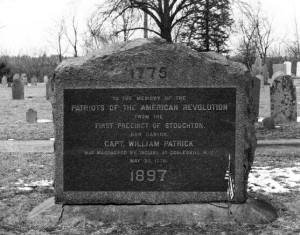True Tales Excerpt: Massacre at Cobleskill
By George T. ComeauThe following is an excerpt from “Massacre at Cobleskill,” the latest installment of True Tales from Canton’s Past by local historian George T. Comeau. The story details the military service and sacrifice of former Cantonite William Patrick.
… Little is known of Patrick’s early Army career. We do know that he was once captured by the British and carried into Canada, and in due course exchanged with other prisoners. On May 12, 1777, Patrick was at home in Stoughton and raised a company of local men who were attached to the 7th Massachusetts Regiment as an infantry regiment of the Continental Army. Organized as seven companies of volunteers from across Massachusetts, it was originally known as Alden’s Regiment after its first colonel, Ichabod Alden.

The monument at Canton Corner dedicated to the Patriots of the American Revolution and Captain William Patrick (Courtesy of the Canton Historical Society)
When Burgoyne surrendered in October of 1777, Patrick was there to satisfactorily witness the British defeat. With the failure of Burgoyne’s Hudson campaign and the Battles of Saratoga, the American Revolutionary War in upstate New York became a frontier war. British leaders in the Province of Quebec supported Loyalist and Native American partisan fighters with supplies and armaments. During the winter of 1777-78, British-allied Indians developed plans to attack frontier settlements in New York and Pennsylvania. When attacks by the natives were rumored to be coming in the spring of 1778, the militia appealed for additional defenses. Colonel Alden sent a company of 30 to 40 men under Captain Patrick to reinforce the local militia.
Arriving in New York on February 25, 1778, Patrick was well aware of the dangers that the Indian tribes posed to the residents of the area. In particular, Thayendanegea or Joseph Brant, a Mohawk, was the military mind behind gathering several tribes of Senecas, Schoharies and Oquagos and leading them into battle. Perhaps the best-known Indian to both the colonists and the British, Brant had met both George Washington and King George III. Unfortunately for Patrick and his men, Brant was a superior warrior and astute foe.
The Indians were dangerous and cunning fighters. Spurred on by a British bounty of $25 for every Colonial scalp, their viciousness was fed by blood lust. Scouts, led by Patrick, were dispatched from Colonel Alden’s regiment. The captain of the local militia, Christopher Brown, warned Patrick that engagements with the Mohawks could be a trap. Brant had over 350 men, two thirds of which were Indians. Small raiding parties began burning homes of the colonists; this was the start of a disastrous chapter in the war.
On the morning of May 30, Brant laid a trap for Captain Patrick. Sending forward a small number of natives as a lure, Captain Patrick’s force and the local militia spotted them near the southern edge of the settlement in what is now the modern-day village of Warnerville, New York, near Cobleskill. Brown warned Patrick, who in turn saw the warning as cowardice. The Scotsman’s bravado flowed easily as he pursued a small band of Indians as they discharged weapons and fled with catcalls. Brant laid in wait. At noon Patrick and his men overtook the fleeing natives, and after about a mile of a running battle, Brant sprung his trap — Patrick’s company instantly engulfed by Brant’s larger force.
Within moments the tide of battle swept upon Patrick and his men. The numbers were not in the Patriots’ favor, 60 men surrounded by more than 300 natives. After several of his men had fallen around him, Captain Patrick received a shot, which broke his thigh. Two of his fellow soldiers, in an attempt to bear him from the field, were surrounded by a party of the enemy and shared his unhappy fate. Within moments, his second in command was killed. The drummer fell, and then the fifer. And then the carnage continued. Left without leadership, half the force was killed and several captured. Brown organized the remaining men and gave the retreat. Fighting tree to tree, the men desperately fell back to a farmhouse. The strategy was clear; Brown’s remaining men must survive and warn the families in the lower valley that a full-scale attack was imminent.
Four or five men took refuge in the farmhouse and held their ground to fire upon the Indians, while the remainder of the men escaped to sound the alarm. Within minutes, hundreds of Native fighters surrounded the house, “whose savage propensities were excited to unmerciful ends. The torch was applied, and the eager, maddening flames, as if jubilant to finish the fiendish work, soon reduced the dwelling to ashes.” During the burning, one of Patrick’s men fled the inferno. He was caught, “and an act of cruelty practiced upon his helpless body that should make the prince of demons blush. His abdomen was opened and his entrails fastened to a tree, and he compelled to walk around it until he sank in untold agony.” The final insult came as the Indians stuffed a roll of Continental currency in his mouth and left him dead …
See the May 28 Canton Citizen to read the full account of “Massacre at Cobleskill.” Click here to order your subscription today.
Short URL: https://www.thecantoncitizen.com/?p=29687










